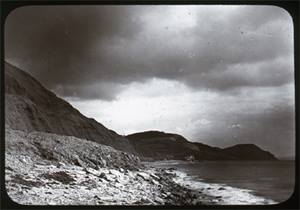Roderick Murchison's account of meeting Mary Anning, 1825

|
View of Lyme Regis from W D Conybeare, et al, 'Ten plates comprising a plan, sections, and views, representing the changes produced on the coast of East Devon, between Axmouth and Lyme Regis by the subsidence of the land and elevation of the bottom of the sea, on the 26th December, 1839, and 3rd of February, 1840', (1840). GSL Library collections.
|
On reaching Lyme Regis on 14 September 1825, Roderick and Charlotte Murchison visited the Anning fossil shop. Although it is now only Mary Anning who is remembered as a fossilist, this first meeting illustrates how much the business was a family affair with her widowed mother Molly displaying her own palaeontological knowledge.

|
|

|
|

|
|

|
| Pages from Roderick Murchison's field diary for 14 September 1825. Archive ref: LDGSL/839/22. Click to enlarge. |
Transcript of Roderick Murchison's field diary for 14 September 1825. (Archive ref: LDGSL/839/22)
"Charmouth Sept 14 1825

|
|
'Lias cliffs Lyme Regis Dorset', by Ananda Kentish Coomarswamy, [1890s-1900s]. LDGSL/1088/AC/GB/48
|
To day to Lyme & sat in the Plesiosaurus Bed with Mary Anning – a drenching rain & yet when we arrived in Lyme old Madame Anning after going over all the varieties from the vulgaris1 upwards – & telling us that all the Ichthyosauri now were vulgares she directed to me to Mary’s trench on the western Beach where I soon discovered her with her dog, hammer & basket – a fine, intelligent young woman – she was looking for a snout or the smallest indication of one of her Sauri by which she might delve out all the animal & the storm of to day was favourable to a discovery – her genius in grouping the dislocated bones of any one of the Sauri is astonishing but the old Lady asserts that all the entire animals have been so found & she was indignant at our supposing that any detached fragments of paddles dorsal fins etc were of the slightest use to her in forming an animal – in that she places no value on these single fragments-
The last large animal [blank] feet long which she exhumed cost them £10 in workmen – it is the Ichthyosaurus tenui-rostris2 so called from its having an enormously long head or beak (nearly the length of the body) – whilst the tail is very short – This was bespoken by his Grace of Buckingham3 & £100 was to be the price but poor Mary is left with her gigantic lizard & the Duke does not demand it – the paddles are rather more imperfect than in the great plesio Saurus which his Grace did purchase & of which we have the cast in the Geo Society4 – this animal is quite a distinct species by the length of snout – the body is most complete & the rounding of the ribs is very striking – taken about 12 months ago.
2 very fine smaller Ichthyosaurus vulgares recently excavated from a bed on the level of the beach – about 3 feet long each – £40 asked for the most perfect – & a Yorkshire Geo Society in treaty for it –
The larger animal was taken from the Cliff in a bed some 12 or 15 feet higher – Mary has all the beds most clearly arranged – The Icthyo. bed – ditto Plesio – ditto of Gryphea incurva – ditto of Plagiostoma &c."
Murchison’s account gives an important insight into Anning’s methodology and practice in finding the more complete specimens. She is looking for fossils after a storm, which is still the best time to find specimens in Lyme Regis. Also, Anning has identified specific beds in which certain specimens can be found. The high costs which had to be borne by the Annings to hire workmen to excavate specimens is also of note. This added to the family’s financial pressures when the promised buyers backed out so prices had to be reduced.
Murchison left his wife in Lyme with Mary Anning to “amuse herself and become a good practical fossilist”, whilst he continued to travel around the coast alone. He returned a fortnight later and was given a tour of the local geology by Anning.
Notes:
1. Vulgaris = Ichthyosaurus communis
2. This specimen was found in June 1824, and drawn by the French geologist Louis Constant Prevost during his visit to Lyme Regis. Anning had great difficulty selling the fossil probably due to its large size - around 13 feet long. The British Museum turned it down in and it was eventually sold to the Bristol Institution towards the end of 1826. It was destroyed during a World War Two air raid in November 1940.
3. Duke of Buckingham who had previously bought Anning's Plesiosaurus dolichodeirus in 1823.
4. The cast was taken by the sculptor (and Member of the Geological Society) Francis Chantrey (1781-1841).
<<Back
Next: Letter to Charlotte Murchison>>